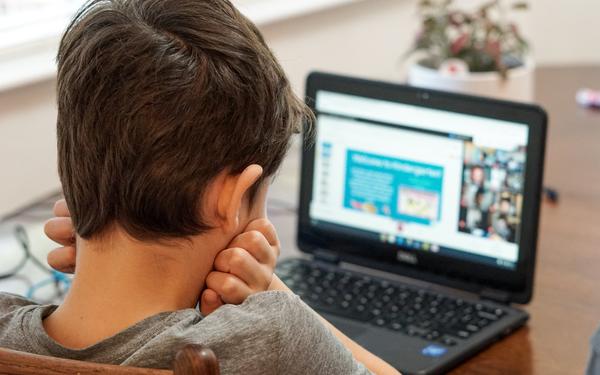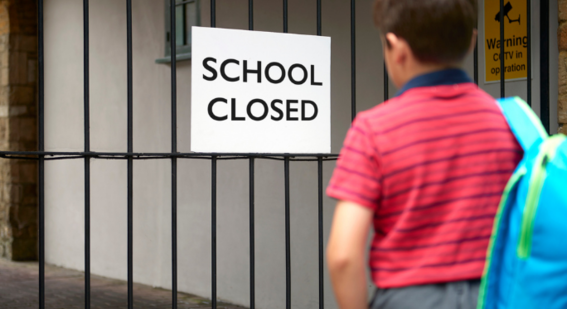What have we learned about the COVID-19 impact on education so far?
In this report, we present a summary of the findings of what we have learned so far about the impact of the COVID-19 pandemic on education systems.

The impact of COVID on education
The impact of COVID-19 on education across the world has been unprecedented and devastating. By mid-April 2020, almost 1.6 billion learners in 190 countries had been affected by school closures, which were happening on a scale never seen before.
With national governments being forced to make difficult priority decisions regarding public health, the economy and other social impacts, widespread school closures are closely connected to the wider socio-economic effects of the COVID-19 pandemic.
While ad hoc solutions were implemented to address the sudden need for remote and online education, the pandemic highlighted how unprepared international education systems were.
As the WHO Director General remarked on 29th June 2020, "this is a moment for all of us to reflect on the progress we have made and the lessons we have learned".. Though it is still difficult to know when it will all end, it is vital for governments to consider longer-term implications and actively seek support and collaboration in finding solutions to address wider underlying solutions.
Cambridge and the effect of COVID-19 on education
During the COVID-19 pandemic, Cambridge has been actively monitoring governments’ response to the crisis, researching and engaging with its partners in government, public society organisations and donors from all over the world.
Our aim is to assess the impact of COVID-19 on their education systems, the solutions they are putting in place for the upcoming return to school, as well as their views on the challenges ahead and their aspirations for the future.
Our government partners are located in Sub-Saharan Africa, the Middle East and North Africa (MENA), Central Europe, South Asia, South East Asia, and South America. a
The public society organisations and donors we have been working with include the Department for International Development (DFID), UNICEF, World Bank, British Council, and various NGOs. Our report ‘What have we learned about the COVID-19 impact on education so far?’ presents a summary of our findings from our collaboration with these governments, organisations and donors.
The effect of COVID-19 on education systems
Widespread school closures on a global scale have affected millions of children, teachers, and education support staff. In the UK, for example, normal schooling was suspended for all but vulnerable children and the children of key workers. Teacher Tapp, a daily survey app for teachers in the UK, revealed that on any given day in 2020 only 17% of primary school teachers and 6% of secondary school teachers were going into school.
School closures due to the COVID-19 pandemic have revealed stark inequalities between and across countries and their education systems. The global digital divide serves as a key indicator of this, with half of all learners who could not be in the classroom due to the pandemic (approximately 830 million students) having no access to a computer according to UNESCO data.
While access to digital education is particularly evident in developing countries, this problem exists across the world, even in wealthier countries. Data from BroadbandNow Research reports that, in the USA, an estimated 42 million people have no internet access. With global education systems relying so heavily on online teaching, accessibility issues may widen the existing learning gap.
On a national level, the disparity between wealthier and poorer students has also been highlighted by the pandemic. For example, in the UK, a Teacher Tapp survey shows that teachers at independent schools were three times more likely to have spoken to students using video conferencing than those at state schools.
There were also disparities regarding preparedness, with private schools more likely to have systems in place for online learning prior to the pandemic compared to state schools. Teacher Tapp survey data showed that, before the first school closures, around 30% of private school teachers already had a platform they could use to broadcast lessons, whereas only 10% of state school teachers had access to such a platform.
Despite the lack of strong research evidence of their positive impact on learning, digital technologies will become one of the main conduits used by education systems to build resilience for the future.
We identified demanding challenges ahead, but also the opportunity to rethink and re-design education to meet the needs of future generations of young people in a world that is likely to be quite different post-pandemic.
Post-pandemic education: future challenges
One of the principal challenges raised by this disruption to global education is that it has damaged the progress that had been made towards the UN’s Sustainable Development Goal 4, which focuses on quality education. The Sustainable Development Goals Report 2021 states that the COVID-19 pandemic has “wiped out 20 years of education gains” across the world.
Potential challenges will also arise regarding how to address the ‘learning loss’ caused by disrupted schooling, which will likely mean that many students have fallen behind the academic expectations set out in national curricula.
While a degree of learning loss was expected, it may have a greater impact than many people would anticipate. A research paper following the 2005 earthquake in Pakistan revealed that just 14 weeks of school closures caused students at all levels to lose between 1.5 and 2 years of schooling. This demonstrates the critical need to plan an effective transition back into normal education as schools reopen.
Technology has become an indispensable part of the education system across much of the world during the pandemic. While research is still ongoing, a few fundamental challenges posed by the increased reliance on technology have been identified, including the need for interactivity, timely feedback for students, and socialising.
Another key challenge that has surfaced during the pandemic so far is the difficulty of collecting data from students when they are not in school, as platforms like Teacher Tapp only survey teachers themselves. Student data would give a clearer idea of what is happening in the home, which would be critical in order to assess the efficacy of current solutions and improve future responses.
Post-pandemic education: opportunities
In spite of all of the challenges that have been caused or exacerbated by the pandemic, the effect of COVID-19 on education systems also provides opportunities to redesign them to be more resilient and equitable in the post-pandemic world.
One of the opportunities we’ve identified is the chance to refine the basic education curriculum by reducing the volume of content and making it more relevant to the current generation of learners. The reduced time and resources available to teachers during the pandemic has forced many to determine which aspects of the curriculum are more important to focus on, which could influence national curricula going forward.
The new post-pandemic world also presents the opportunity for us to rethink the skills and qualities that are prioritised within our education systems. With industries like health and social care experiencing labour shortages, skills including collaboration, empathy and emotional intelligence may be considered more essential by employers, and teaching would need to reflect this shift in attitudes.
Additionally, the increased use of technology across all industries - not just education - means that digital capabilities will become even more vital within the labour market, another change for which schools would need to prepare students.
In addition to reconsidering priorities regarding curricula and skills, post-pandemic education systems also have the opportunity to rethink assessments and examinations. Similarly to many other countries, secondary school exams in the UK were cancelled in 2020 and in 2021, which meant that alternative methods of awarding grades had to be conceived. This new approach to assessments may influence the format, purpose and mode of delivery of future examinations.
The COVID-19 pandemic and its resultant school closures also present the opportunity to reevaluate the role of teachers within our global post-pandemic education systems. As many parents have had to step in and take on some of the responsibility of educating children, there has been a reappreciation of the importance and complexity of the role of teachers.
Moreover, the adoption of new technologies to assist with teaching highlights many ways that teachers’ jobs could be made easier. Teacher Tapp data showed that 75% of teachers were working less than 7 hours per day in April 2020 compared to just 10% around 18 months earlier. This change can likely be partially credited to teachers having their own childcare responsibilities, with over one-third of teachers having to educate their own children in addition to working. However, their working hours may also be reduced by online applications assisting with tasks including marking and activity setting.
Cambridge report: what have we learned about the COVID-19 impact on education so far?
In this report, we present a summary of what we have learned so far about the effect of the COVID-19 pandemic on education systems; we will continue actively engaging with the wider global education community to support governments in designing effective solutions that address their current and future challenges.




